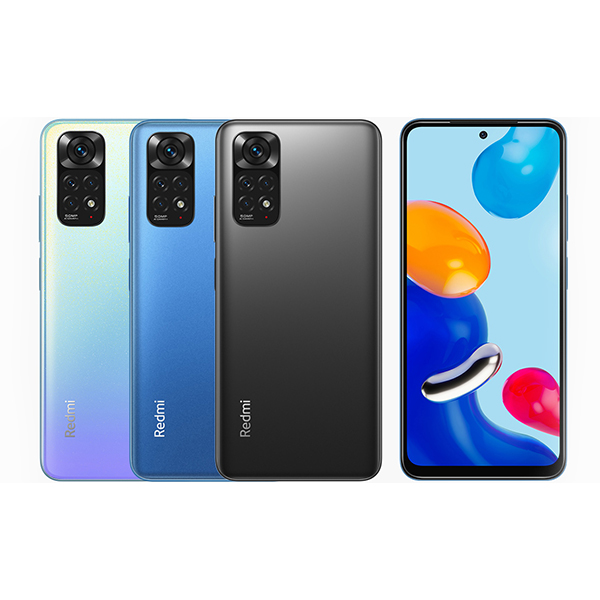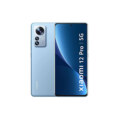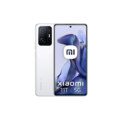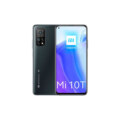Xiaomi Redmi Note 11




Specs
General
| Device Type | Xiaomi Redmi Phone |
| Announced | 22 January, 2022 |
| Released | 09 February, 2022 |
| Status | Available |
Design
| Water Resistant | IP53, splash-proof |
| Dimensions | 159.9 x 73.9 x 8.1 mm |
| Weight | 179 g |
| Protection | Glass front (Gorilla Glass 3), plastic back, plastic frame |
| Colors | Graphite Gray, Twilight Blue, Star Blue |
Display
| Refresh Rate | 90 Hz |
| Display Type Display Technology => A number of display technologies and types used in mobile phones => TFT (Thin Film Transistor), IPS (In-Place Switching), OLED (Organic Light Emitting Diode), AMOLED (Active-Matrix Organic Light-Emitting Diode), Super AMOLED (an even advanced version of AMOLED), Resistive Touchscreen (Resistive touchscreens contain two layer of conductive material with a very small gap between them which acts as a resistance), Capacitive Touchsceen (Capacitive touchscreen technology consists of a layer of glass coated with a transparent conductor) | AMOLED |
| Size | 6.43 inches |
| Resolution | 1080x2400 px (FHD+) |
| Display Colors Display Colors is refers to the number of different shades of colors that the screen is capable of displaying => 64K colors, 256K colors and 16 million colors, Obviously 16M is highest available range of colors and better than others. | 16M Colors |
| Pixel Density Pixel Density (PPI) is refers to the concentration of pixels on a particular display, measured in pixels per inch (ppi). Pixel density is calculated by dividing the diagonal pixel resolution of a display by its diagonal size, higher pixel density better display quality. | ~409 ppi |
| Touch Screen | Capacitive Touchscreen, Multitouch |
| Display Protection Display Protection => Gorilla Glass is a special alkali-aluminosilicate glass shield with exceptional damage resistance that helps protect mobile displays from scratches, drops, and bumps of everyday use, It is always better to go for a smartphone with Gorilla Glass for that added protection and peace of mind. | Corning Gorilla Glass 3 |
| Features | 1000 nits peak brightness, DCI-P3, Always-on display |
| Secondary Display | No |
Camera
| Front Camera | 13 MP, f/2.4, (wide), 1/3.1", 1.12µm |
| Camera Setup | Quad |
| Main Camera Camera is able to capture photographs and usually videos, The most important characteristics of a camera are the resolution (measured in megapixels), lens focus type (fixed or automatic), higher megapixel cameras are known to capture higher quality photos, but not always a good measurement of the photos quality. |
50 MP, f/1.8, 26mm (wide), 1/2.76", 0.64µm, PDAF 8 MP, f/2.2, 118˚ (ultrawide), 1/4.0", 1.12µm 2 MP, f/2.4, (macro) 2 MP, f/2.4, (depth) |
| Image | 8150 x 6150 Pixels |
| Video | 1080p@30fps |
| Camera Features | Geo-tagging, Phase detection, touch focus, HDR, Panorama |
| Flash Flash Light => There is commonly two types of flash lights are used in camera mobile phones, LED Flash (LED flash offers lower power consumption with drive circuitry that takes up very little room, LEDs can be strobed faster than any other light source), Xenon Flash (xenon flash produces an extremely intense full-spectrum white light for a very short duration) | LED flash |
Hardware
| Operating System OS => Every computer system run on a base software called Operating System (OS). Operating System controls all basic operations of the computer (such as smartphone, PDAs, tablet computers and other handheld devices). The Operating System allows the user to install and run third party applications (apps), apps are used to add new functionality to the device. | Android 11 |
| Chipset Chipset is a group of integrated circuits designed to perform one or a more dedicated functions, often with real time computing constraints, Popular smartphones are equipped with more advanced embedded chipsets that can do many different tasks depending on their programming. | Qualcomm Snapdragon 680 4G |
| CPU CPU (Central Processing Unit) mostly known as processors, CPU processes instructions in order to carry out certain functions that make your device operate properly. Processors are often described as the brain of computers, smartphones and tablets, Smartphones and tablets rely on processors to carry out their every task, Processors are an incredibly important factor in selecting any type of computing device, including your smartphone. | Octa-core (4 x 2.4 GHz Kryo 265 Gold + 4 x 1.9 GHz Kryo 265 Silver) |
| Architecture | 64 bit |
| Fabrication | 6 nm |
| GPU GPU (Graphics Processing Unit) is a single-chip processor designed to rapidly manipulate and alter memory to accelerate the creation of images in a frame buffer intended for output to a display, This includes things such as lighting effects, object transformations, and 3D motion. | Adreno 610 |
| RAM (Memory) RAM (Random Access Memory) is a type of computer memory that can be accessed randomly, any byte of memory can be accessed without touching the preceding bytes that allows information to be stored and accessed quickly from random locations. RAM is the most common type of memory found in computer systems, smartphones, tablets and other electronic devices. | 4 GB |
| Internal Storage Internal Storage is a data storage space (flash memory) mostly used in smartphones, tablets and other electronic devices where operating system, apps, music, photos, videos, files and other user data Is stored. | 128 GB |
| Card Slot Memory Card Slot is a special slot for inserting a memory card. Memory cards allow you to expand the phone's built-in memory, A memory card (sometimes called a flash memory card or a storage card) is a small storage medium used to store data such as text, pictures, audio, and video, for use on small, portable or remote computing devices such as mobile phones, mp3 players, digital cameras. | |
| Sensors Sensors are electronic components that detects and responds to some type of input from the physical environment. The specific input could be light, heat, motion, moisture, pressure and location, The output is generally a signal that is converted to use in computing systems, a location sensor, such as a GPS receiver is able to detect current location of your electronic device. | Side-mounted fingerprint sensor, accelerometer, gyro, proximity, compass |
Network
| SIM TYPE SIM (Subscriber Identity Module) is a small card that contains mobile network subscriber's account information. This allows the phone using the card to attach to a mobile network. The SIM card is most commonly associated with GSM and UMTS mobile networks. Moving a SIM card from one phone to another allows a subscriber to switch mobile phones without having to contact their mobile network carrier. SIM cards can also be used by a phone to store limited amounts of data, such as phone numbers and text messages. | Nano SIM |
| SIM Technology | Dual SIM (nano-SIM and eSIM) |
| 2G Network | GSM 850 / 900 / 1800 / 1900 |
| 3G Network | HSDPA 850 / 900 / 1700(AWS) / 1900 / 2100 |
| 4G Network | LTE band 1(2100), 3(1800), 5(850), 7(2600), 8(900), 40(2300), 41(2500) |
Multimedia
| FM Radio | |
| Stereo Speakers | YES |
| Loudspeaker | YES |
| Audio Jack | 3.5mm jack |
| Audio Features | 24-bit/192kHz audio |
Connectivity
| Wi-fi Wi-Fi is a popular wireless networking technology using radio waves to provide high-speed network connections that allows devices to communicate without cords or cables, Wi-Fi is increasingly becoming the preferred mode of internet connectivity all over the world. | Wi-Fi 802.11 a/b/g/n/ac, dual-band, Wi-Fi Direct |
| Bluetooth Bluetooth is a wireless communications technology for exchanging data between mobile phones, headsets, computers and other network devices over short distances without wires, Bluetooth technology was primarily designed to support simple wireless networking of personal consumer devices. | 5.0, A2DP, LE |
| GPS GPS The Global Positioning System is a satellite-based radio navigation system, GPS permits users to determine their position, velocity and the time 24 hours a day, in all weather, anywhere in the world, In order to locate your position, your device or GPS receiver must have a clear view of the sky. | A-GPS, GLONASS, BDS, GALILEO |
| USB | USB Type-C 2.0, USB On-The-Go |
| EDGE EDGE (Enhanced Data GSM Environment) is a wireless network technology generally considered the next step in the 2G network offers data transfer rates up to four times faster than ordinary GSM networks, Generally, EDGE is used for the purpose of wireless data transfer, such as sharing pictures and videos or browsing the Internet via a mobile phone connection. | |
| GPRS GPRS (General Packet Radio Service) is a packet oriented mobile data service on the 2G and 3G cellular communication system's global system for mobile communications (GSM), Generally, GPRS is used for the purpose of wireless data transfer, such as sharing pictures and videos or browsing the Internet via a mobile phone connection. | |
| Speed | HSPA 42.2/5.76 Mbps, LTE-A |
| Wi-fi Hotspot | |
| NFC NFC (Near field communication) is a set of standards for smartphones and similar devices to establish peer-to-peer radio communications with each other by touching them together or bringing them into proximity, usually no more than a few inches. |
Features
| Messaging | SMS(threaded view), MMS, Email, Push Mail, IM |
| Web Browser Web Browser => a web browser is a software application used to locate, retrieve and display content on the World Wide Web, including Web pages, images, video and other files, The primary function of a web browser is to render HTML, the code used to design or markup webpages. | HTML5 |
| Games | Built-in + Downloadable |
| Torch |
Battery
| Battery Type Battery Type => Cell phones run on various kinds of batteries depending on the manufacturer, phone size or shape and features. There are basically four types of cell phone batteries => Lithium Polymer, Lithium Ion, Nickel Metal Hydride and Nickel Cadmium. | Li-Ion (Lithium Ion) |
| Capacity Battery Capacity is a measure (typically in Amp-hr) of the charge stored by the battery, and is determined by the mass of active material contained in the battery. The battery capacity represents the maximum amount of energy that can be extracted from the battery under certain conditions. | 5000 mAh |
| Placement | Non-removable |
| Wireless Charging Wireless Charging (Inductive Charging) uses an electromagnetic field to transfer energy between two objects. This is usually done with a charging station. Energy is sent through an inductive coupling to an electrical device, which can then use that energy to charge batteries or run the device. | No |
| Standby Standby Time is the total amount of time that you can leave your is fully charged, turned on and ready to send and receive calls or data transmissions before completely discharging the battery. | Up to 550 hours (estimated) |
| Talk Time Talk Time is the longest time that a single battery charge will last when you are constantly talking on the phone under perfect conditions, Ambient temperature and highly dependent on the cellular network environment such as the distance to the closest cell network tower. | Up to 32 hours (estimated) |
| Music Play | Up to 100 hours (estimated) |
| Extra |
Fast charging 33W, 100% in 60 min (advertised) Power Delivery 3.0 Quick Charge 3+ |
Xiaomi Redmi Note 11 Detailed Review
The Xiaomi Redmi Note 11, launched in early 2022, is part of Xiaomi’s popular Redmi Note series, known for offering impressive specs at an affordable price. With a focus on delivering strong performance, a good display, and solid battery life, the Redmi Note 11 is targeted at budget-conscious users who still want a well-rounded smartphone experience. This detailed review will cover its design, display, performance, camera capabilities, battery life, software, and a pros & cons summary.
Specifications at a Glance
- Display: 6.43-inch AMOLED, 90Hz, Full HD+ (1080 x 2400 pixels)
- Processor: Qualcomm Snapdragon 680 (6nm)
- RAM: 4GB / 6GB / 8GB
- Storage Options: 64GB / 128GB (expandable via microSD)
- Rear Cameras: Quad Camera setup (50 MP main, 8 MP ultra-wide, 2 MP macro, 2 MP depth)
- Front Camera: 13 MP
- Battery: 5,000 mAh with 33W fast charging
- Operating System: MIUI 13 based on Android 11 (upgradable to Android 12)
- Audio: Stereo speakers, 3.5mm headphone jack
- Dimensions: 159.9 x 73.9 x 8.1 mm
- Weight: 179 grams
Design and Build Quality
Aesthetics:
- Premium Look: The Xiaomi Redmi Note 11 features a sleek design with a matte-finish plastic back that feels sturdy and resistant to fingerprints. The flat edges give it a modern look, similar to higher-end devices.
- Color Options: It is available in a variety of colors, including Graphite Gray, Twilight Blue, and Star Blue, offering a subtle yet elegant look.
Ergonomics:
- Lightweight and Slim: Weighing only 179 grams and being just 8.1 mm thick, the Xiaomi Redmi Note 11 is quite comfortable to hold and use, even for extended periods.
- Fingerprint Sensor: The side-mounted fingerprint sensor integrated into the power button is responsive and convenient to use.
- Water Resistance: The device is IP53 splash-proof, meaning it offers basic protection against light splashes but not full waterproofing.
Conclusion: The design of the Xiaomi Redmi Note 11 is both practical and visually appealing, with a solid build quality that feels more premium than its price suggests.
Display
Specifications:
- Size: 6.43-inch AMOLED
- Resolution: 1080 x 2400 pixels (Full HD+)
- Refresh Rate: 90Hz
- Brightness: Up to 1000 nits peak brightness
- Protection: Corning Gorilla Glass 3
Performance:
- AMOLED Quality: The AMOLED panel provides vibrant colors, deep blacks, and excellent contrast, making it a significant upgrade over the LCD panels seen on many budget phones.
- 90Hz Refresh Rate: The 90Hz refresh rate ensures smoother scrolling and animations, providing a more fluid user experience compared to 60Hz displays.
- Outdoor Visibility: With up to 1000 nits of peak brightness, the Xiaomi Redmi Note 11’s display performs well even in bright outdoor conditions.
In summary, the display on the Xiaomi Redmi Note 11 is one of its strongest points, offering a high-quality visual experience that is uncommon in this price range.
Performance
Hardware:
- Processor: Qualcomm Snapdragon 680, a mid-range chipset built on a 6nm process, which balances power efficiency and moderate performance.
- RAM and Storage Options: The device comes with 4GB, 6GB, or 8GB of RAM, and 64GB or 128GB of internal storage, with the option to expand storage via microSD.
Day-to-Day Performance:
- General Usage: The Xiaomi Redmi Note 11 handles day-to-day tasks such as browsing, social media, and media consumption smoothly. It performs adequately in multitasking scenarios as well, though the base 4GB RAM variant may struggle with more demanding apps.
- Gaming: For casual gaming, the Snapdragon 680 is competent, but for more graphically intense games like Call of Duty: Mobile or PUBG, you may need to lower the graphics settings to ensure smooth gameplay.
Benchmark Scores:
- AnTuTu: Approximately 250,000 points, which is respectable for a budget phone but not suitable for heavy gaming or advanced multitasking.
- Geekbench 5: Scores around 375 (single-core) and 1550 (multi-core).
Conclusion: The Xiaomi Redmi Note 11 provides satisfactory performance for most users but isn’t meant for power users or heavy gaming. For daily activities, social media, and light gaming, it performs well, but there are better options for more performance-intensive tasks.
Camera
Rear Camera Setup:
- Main Camera: 50 MP, f/1.8 (wide)
- Ultra-Wide Camera: 8 MP, f/2.2, 118° field of view
- Macro Camera: 2 MP, f/2.4
- Depth Sensor: 2 MP, f/2.4
Front Camera:
- Resolution: 13 MP, f/2.4
Camera Performance:
- Daylight Photography: The 50 MP main sensor delivers excellent photos in good lighting conditions, with decent sharpness, color accuracy, and dynamic range. For a budget phone, the photos are impressive, particularly in natural light.
- Low-Light Photography: In low-light conditions, the camera struggles without a dedicated night mode. The images tend to lack detail and have visible noise, but using the night mode improves results slightly, though not to a premium standard.
- Ultra-Wide: The 8 MP ultra-wide camera is serviceable, but it lacks the detail and sharpness of the main sensor. Distortion at the edges is also noticeable, though this is common in budget devices.
- Macro and Depth Cameras: The 2 MP macro and depth sensors feel more like marketing additions than practical tools. The macro shots lack detail, and the depth sensor is functional for portrait shots but doesn’t add significant value.
Video Recording:
- Resolution: 1080p at 30fps (no 4K recording)
- Stabilization: Lacks any advanced stabilization, so videos can appear shaky without a steady hand.
Conclusion: The camera system on the Xiaomi Redmi Note 11 is solid for its price, offering good performance in daylight and a decent ultra-wide option. However, low-light performance and video capabilities are where it shows its budget limitations.
Battery Life
Specifications:
- Capacity: 5,000 mAh
- Charging: 33W fast charging (charger included in the box)
Performance:
- All-Day Battery: With a 5,000 mAh battery, the Xiaomi Redmi Note 11 can easily last a full day of moderate to heavy use, including social media, streaming, and some gaming.
- Power Efficiency: The Snapdragon 680 chipset is optimized for efficiency, and with the 90Hz AMOLED display, it strikes a good balance between performance and battery life.
- Charging Speed: The 33W fast charging is a major advantage in this price range, taking the phone from 0 to 100% in about an hour.
Conclusion: Battery life is one of the standout features of the Xiaomi Redmi Note 11, with its large battery and fast charging making it a great choice for users who prioritize long-lasting power.
Software and Features
Operating System:
- MIUI 13 on Android 11: The Xiaomi Redmi Note 11 comes with MIUI 13 based on Android 11. MIUI is known for its customization options but can be heavy on system resources due to pre-installed apps (bloatware).
- Software Updates: While MIUI offers regular updates, the phone initially ships with Android 11, which is slightly outdated for a phone released in 2022.
User Experience:
- Smooth UI: The 90Hz refresh rate adds fluidity to the user interface, making everyday interactions feel more responsive.
- Bloatware: One downside of MIUI is the presence of pre-installed apps, which can take up space and occasionally push notifications. However, most of these apps can be uninstalled or disabled.
Conclusion: MIUI offers a feature-rich experience, but the presence of bloatware and being slightly behind on Android versions may be drawbacks for some users.
Audio and Connectivity
Audio:
- Stereo Speakers: The inclusion of stereo speakers is a pleasant surprise in this price range, offering loud and clear audio for media consumption.
- Headphone Jack: The 3.5mm headphone jack is a welcome addition for those who prefer wired headphones.
Connectivity:
- 5G Support: The global version does not have 5G, which might be a limitation for future-proofing the device. However, it still supports 4G LTE, Wi-Fi 5, Bluetooth 5.0, and has an infrared port for remote control features.
Conclusion: Audio performance is impressive for a budget phone, but the lack of 5G support may limit its appeal to users looking for future-ready connectivity.
Pros and Cons
Pros:
- Excellent AMOLED Display: Vibrant colors, deep blacks, and a smooth 90Hz refresh rate enhance the user experience.
- Great Battery Life: The 5,000 mAh battery with 33W fast charging ensures all-day battery life and quick charging.
- Solid Build Quality: Despite its plastic construction, the design and build feel premium for its price.
- Decent Daylight Photography: The 50 MP main camera performs well in good lighting conditions.
- Stereo Speakers & Headphone Jack: Stereo speakers provide good audio, and the inclusion of a headphone jack is convenient.
Cons:
- No 5G Support: The lack of 5G may be a dealbreaker for those looking for future-proof connectivity.
- Average Low-Light Camera Performance: The camera struggles in low-light conditions, even with night mode enabled.
- Bloatware in MIUI: Pre-installed apps and advertisements in the software can be annoying for users.
- Limited Gaming Performance: While fine for casual gaming, the Snapdragon 680 chipset isn’t ideal for intensive games.
- No 4K Video Recording: Video recording is limited to 1080p at 30fps, which may be a limitation for content creators.

Conclusion
The Xiaomi Redmi Note 11 is a strong contender in the budget smartphone market, offering an impressive display, great battery life, decent cameras, and a solid design. While it lacks 5G support and falls short in gaming and low-light photography, it more than makes up for it with its affordability, smooth performance in day-to-day tasks, and quality AMOLED display. For users seeking a budget phone with a well-rounded feature set, the Redmi Note 11 is an excellent option.
Review
Disclaimer Note
All prices in Pakistan is updated daily from the price list provided by local shops and dealers but we can not guarantee that the information / price on this page is 100% correct (Human error is possible), always visit your local shop for exact cell phone cost & rate.














